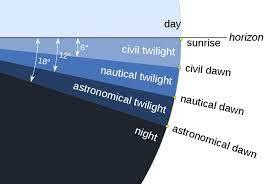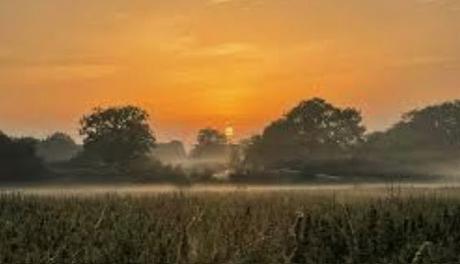
twilight by degrees
That was a surprise. And so was the fact that you can have twilight in the morning (as above) but no one bothers with that. Here are the evening ones:Stage 1: Civil twilightCivil twilight begins the moment the sun slips below the horizon. The official definition of civil twilight is the time from when the sun disappears until the sun’s center is 6 degrees below the horizon. A measurement of 6 degrees of sky is a bit more than three fingers held at arm’s length.During civil twilight, there’s enough light to see and the streetlights are starting to come on. The brightest planets appear during civil twilight.Stage 2: Nautical twilightNautical Twilight is the time period when the center of the sun is 6 degrees below the horizon to 12 degrees below the horizon. The term dates back to when sailors used the stars for navigation and more bright stars were visible which could be used as directional cues.During nautical twilight, terrestrial objects are visible, but you need artificial lights to carry on outdoor activities.Polar regions have nautical twilight all night long, never reaching astronomical twilight or total darkness.Stage 3: Astronomical twilight
Astronomical twilight is the darkest twilight stage. The definition of astronomical twilight is the period of time when the center of the sun is 12 degrees below the horizon to 18 degrees below the horizon. For stargazers, this is the time when fainter stars, clusters and other sky objects appear and become good observing targets. So, as a rule of thumb, if you’d like to observe something in the night sky that isn’t particularly bright, you should wait about 90 minutes after sunset before you start observing.When I was looking up the above I sometimes found twilight and dusk in the same articles and it made me think of other names given to this time of day. How they have a certain poetic feeling. How about gloaming, evenfall, crepuscule, dimmet, dimpsy or da simmer dim which is the twilight of a Shetland summer evening. Actually, I’m not sure about crepuscule.I’ve just remembered that when I lived in London working at Charing Cross Hospital a group of us used to get out on Saturdays for walks. We would get a train and head out, usually south or west. For instance, we used to love coming off the Downs and into Brighton or Eastbourne and timing it such that we could walk along their Promenades, thus avoiding twilight, and catch the train back after a few pints.And I mention this because I recall one such day that is relevant to the topic. Three of us had been exploring the countryside out in the sticks, I can’t remember where exactly, but it was getting dark and a couple of miles to go to the pub next to whatever station we were heading for. This is for Anne and Andy.

twilight imminent
End of a Walk in BedfordshireOn the far side of the wood
an early evening bonfire
settled for the night,
winter branches hung around
undecided between certain heat
and the soft glow of windows
where football scores
flickered unexpectedly
under a thatched roof.
To the right a friend talked
making solid points with his hands,
brushing to the side brambles
and logical uncertainties,
each fence post we followed
linked by unbroken concentration.
Behind us a friend paused,
lost in thought and twilight,
her single note
drawn on barred gates,
turning as logs crashed
sending scales sparking
through choirs of beech and oak
and on other days
I may have gone back,
I really don’t know,
but I stopped him
just short of the road
and we waited in silence
with precise looks of impatience.Thanks for reading, Terry Q.
Email ThisBlogThis!Share to TwitterShare to Facebook
